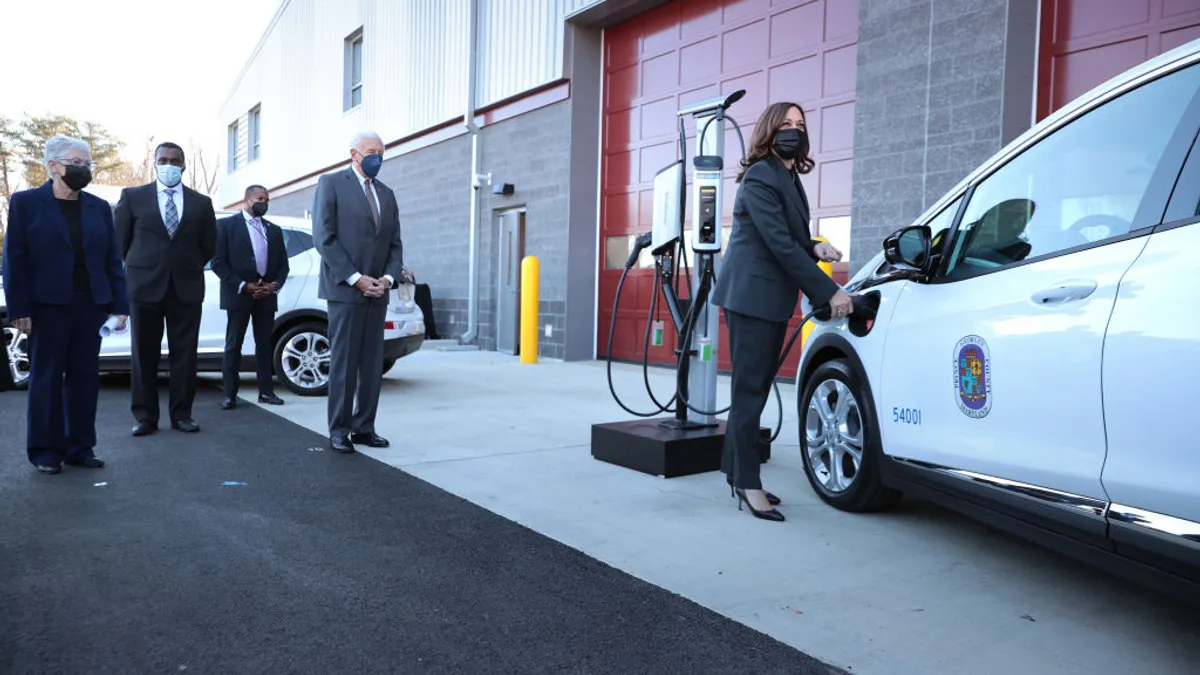Dive Brief:
- The White House on Monday unveiled an "EV Charging Action Plan" that sketches out how federal agencies will coordinate on the development of a national network of 500,000 electric vehicle chargers.
- The action plan establishes a Joint Office of Energy and Transportation, coordinated by the Department of Energy and the Department of Transportation, aiming to provide stakeholders with a coordinated approach and single point of contact for charging resources.
- The new joint office will be critical to facilitating a smooth and equitable rollout of taxpayer funded infrastructure, said EV advocates. "Too often, localities and other stakeholders can't easily access federal funding because of difficult grant application processes," Zero Emission Transportation Association spokesman Daniel Zotos said in an email.
Dive Insight:
Vice President Kamala Harris announced the action plan Monday, laying out how the federal government will help to administer $7.5 billion to develop a national charging network. The funding was included in the bipartisan infrastructure package, signed by President Joe Biden in November.
"We are making the largest ever investment in electric vehicle infrastructure and technology in our nation’s history" through the bipartisan infrastructure legislation, Harris said. The new charging plan and joint office "will ensure agencies are working together for the implementation of this law," she said.
On Tuesday, Secretary of Energy Jennifer Granholm and Secretary of Transportation Pete Buttigieg are expected to sign a memorandum of understanding to leverage agency resources, including DOE’s national laboratories. "This will provide states, communities, industry, labor, and consumer groups with a coordinated federal approach and a 'one-stop-shop' for resources on EV charging and related topics," the White House said in a statement.
The White House also plans to hold a series of stakeholder meetings regarding the planned charging network, with topics to include: partnerships with state and local government; domestic manufacturing; equity and environmental justice; civil rights; partnering with tribal communities; and maximizing environmental benefits.
DOT and DOE will launch a new Advisory Committee on Electric Vehicles separately from the new joint office, focused on gathering input. The agencies plan to appoint committee members by end of the first quarter of 2022. There is also forthcoming guidance and standards related to the charging network.
By Feb. 11, the White House said DOT will publish guidance for states and cities that "will look at where we already have EV charging and where we need — or will need — more of it." The guidance will focus on the needs of disadvantaged and rural communities.
And by May 13, DOT will publish standards for EV chargers in the national network "to ensure they work, they’re safe, and they’re accessible to everyone."
DOT is also planning a new solicitation for Alternative Fuel Corridors, which can provide grants for charging infrastructure. The Federal Highway Administration "will establish a recurring process to regularly update these corridors," according to the White House.
Close coordination between local stakeholders and the federal government can help move infrastructure funds into communities where charging infrastructure is most needed, say advocates.
"Because the EV charging program is new to the DOT, it is vital that the department works closely with stakeholders to determine how to deploy EV charging infrastructure," Zotos said. DOT "must make sure that communities can easily access this funding and deploy these chargers in ways that will accelerate electrification [of] transportation as quickly as possible."
And the rollout must be equitable, EV advocates stressed.
"The communities that are least able to afford lawyers and lobbyists to secure this funding are the communities that could be most benefited by electrified transportation," Zotos said.
The White House's EV charging plan can help achieve two key outcomes for a national network, said Joel Levin, executive director of Plug in America.
The first is to create a "uniform consumer experience" across the coast-to-coast EV charging network that is at least comparable to the process of buying gasoline. "I don’t love gasoline, but I think that the retail gasoline network has done a good job in creating a uniform and convenient experience," said Levin.
And second, the network must set aside funds to support EV charging at home for low and moderate income consumers in multi-unit dwellings, "since they are the folks who will likely have the hardest time accessing charging."
Biden has set a goal for half of all new passenger vehicle sales in the United States to be electric vehicles by 2030. Observers say reaching that target is achievable, but will require placing charging infrastructure in locations where it can be most useful.
"It's clear the White House is recognizing the critical impact of EV charging in the energy landscape and its contribution to a more sustainable future," Luis D'Acosta, executive vice president of Schneider Electric's digital energy global business, said in an email. "Success, however, lies in how the plan is executed, and efficient deployment of these charging stations will lean on their convenience and location."















